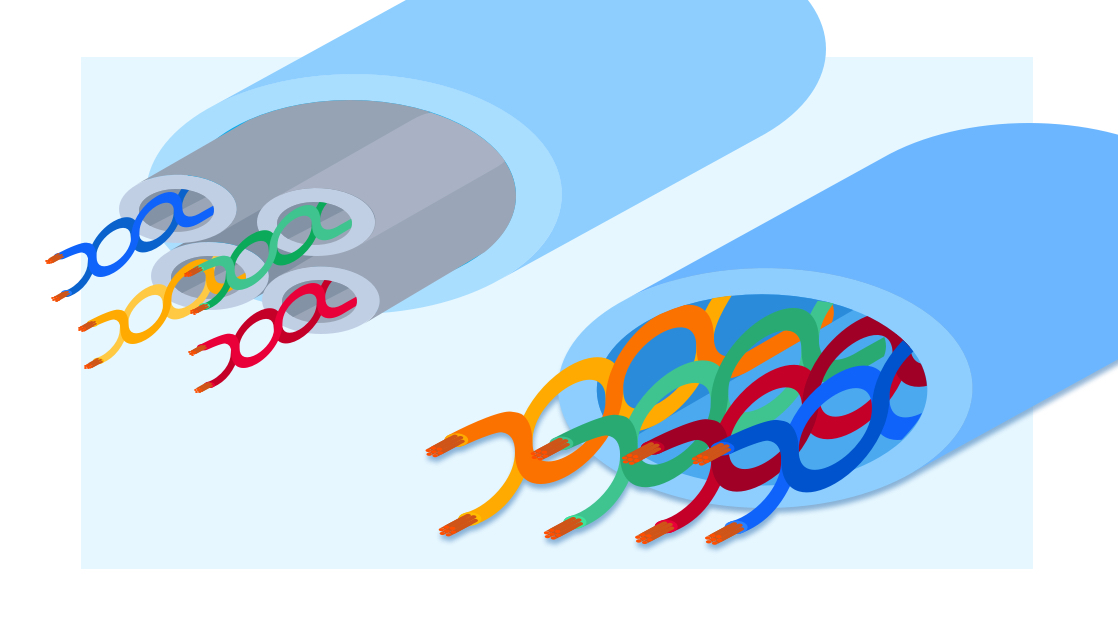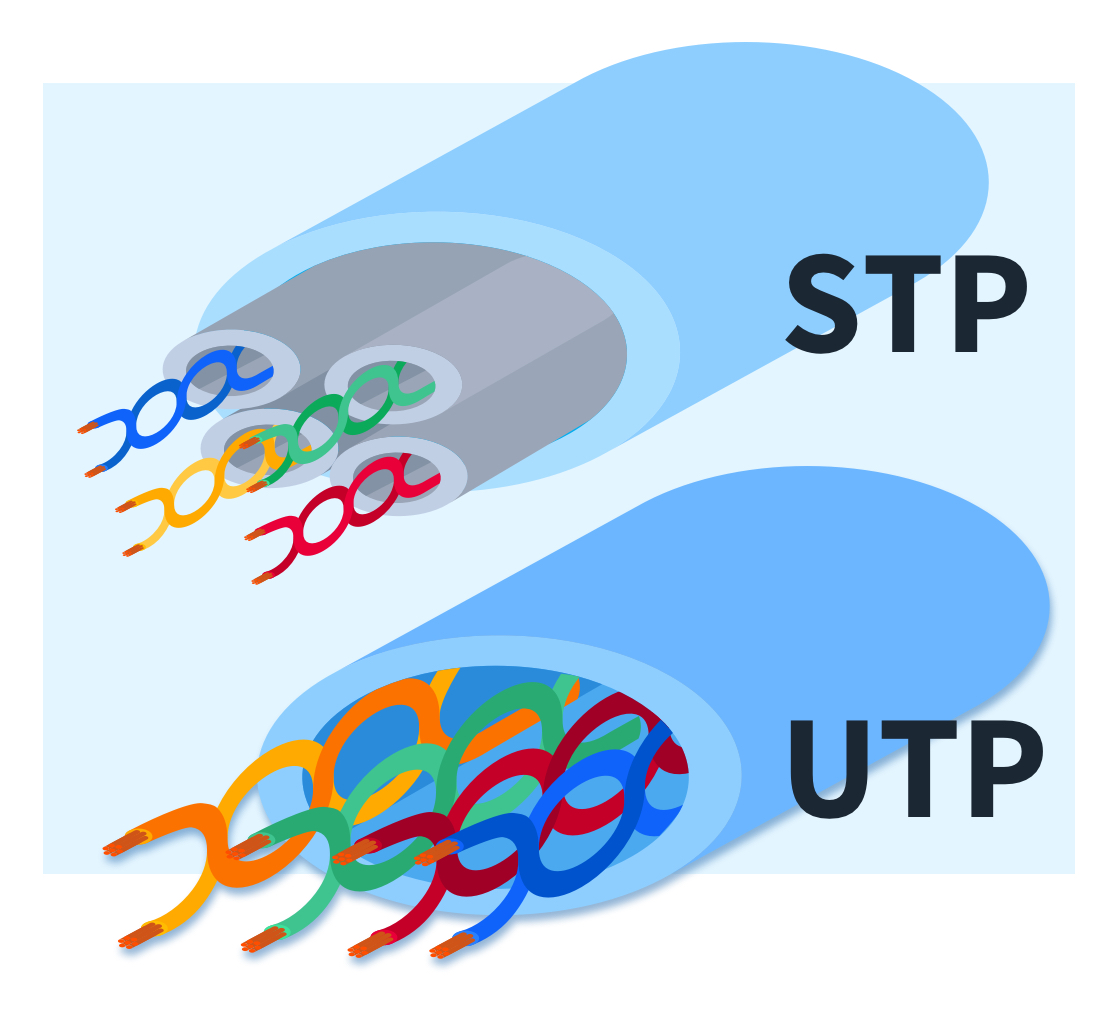UTP vs. STP: Understanding the Differences in Ethernet Cable Types

Quick definition: UTP (Unshielded Twisted Pair) cables are widely used for Ethernet connections due to their cost-effectiveness and simplicity. In contrast, STP (Shielded Twisted Pair) cables have an additional protective shield to reduce electromagnetic interference, enhancing data integrity in environments with potential interference. Choosing between UTP and STP depends on your network environment and the need for protection against external interferences. Navigating untamed tangles of network cables in a server room can feel like exploring an uncharted jungle. Luckily, we have gathered the tips and tricks to make it out unscathed, starting with understanding which cable types you're dealing with. Whether you're wiring up your home office or installing a server rack, the biggest decision facing any network cabling project is: shielded or unshielded?
The differences between shielded twisted pair (STP) and unshielded twisted pair (UTP) cables can be confusing, but it doesn't have to be! Get ready to become a cabling pro as we unravel the differences between these two fundamental cable types. By the end, you'll know which option is right for your next networking project.
Common UTP Standards
UTP cables are standardized by organizations like the Telecommunications Industry Association (TIA) and the International Organization for Standardization (ISO) to ensure interoperability and certified performance levels.
Key standards include:
The TIA-568-C.2 standard is the most widely used standard for UTP cabling in the United States.
The ISO/IEC 11801 standard is the international standard aligned with TIA-568-C.2.
The EN 50173 standard is the European UTP cabling standard aligned with ISO/IEC 11801.
Following these industry standards is essential for mission-critical systems, where failure of the cabling could have serious consequences (like in a data center or operations center). These standards help ensure UTP cables from different manufacturers work together reliably and meet the strictest performance requirements.
What are Unshielded Twisted Pair (UTP) Cables?
UTP cables contain pairs of copper wires twisted together and wrapped in a plastic insulation sleeve. The twists in each pair help reduce interference, induction, and crosstalk between the individual wires. UTP cables also come in different categories that specify their performance capabilities. Below is a list of UTP categories and some important stats.

UTP Cable Categories
Category 5e (Cat5e) cables are commonly used (and cheapest) for 1000Base-T Gigabit Ethernet networks, although it is not officially certified. They can transmit data up to 1 Gbps and operate at frequencies up to 100MHz.
Category 6 (Cat6) cables can transmit 10 Gbps networks over short distances. They double the maximum operating frequency to 250MHz compared to Cat5e.
Category 6a (Cat6a) cables push performance to 500MHz frequency and can sustain 10 Gbit connections up to 100 meters.
Category 7 (Cat7) cables are the highest UTP standard, operating at 600MHz frequency and able to transmit 10Gbps up to 100 meters.
Higher-category UTP cables have more stringent requirements for crosstalk prevention and signal quality for mission-critical systems that can’t tolerate interference in their operations. A key advantage of UTP cables is their lower cost compared to similar shielded cables with the same performance.
UTP Cable Advantages
UTP cables are flexible and have a smaller diameter, making them easier to install when pulling the cables through trunking and pipes, and organizing them in the rack is easier as they are more pliable and easier to route to their respective patch panels and IT equipment.
They use simple, cost-effective RJ-45 connectors that are only a few cents each.
Wide availability and competition help lower UTP cable pricing as there are many manufacturers to choose from
The variety of UTP categories makes finding cost-effective cables that meet performance requirements easier.
UTP Cable Disadvantages
Lack of shielding makes UTP cables more susceptible to EMI and signal interference at longer distances or high frequencies. This limits the locations where this cable can be used, like factories and near high-voltage equipment.
Not ideal for very long cable runs due to attenuation. (Loss of signal strength and it is measured in decibels per 100 meters)
Higher-category UTP cables can be more rigid and difficult to work with due to internal plastic rodding that makes them quite stiff.
UTP cables offer the best value for typical Patch cables, desktop connections, and short LAN runs like connecting PCs to outlets. They are the go-to choice for homes and offices that don't need extreme network speeds. These cables are generally shorter and are easier to handle, making them ideal for ‘user-facing’ equipment.
What are Shielded Twisted Pair (STP) Cables?
STP cables add an extra layer of shielding around the twisted pairs to block electromagnetic interference (EMI). This helps prevent signal leakage and reduces crosstalk issues, protecting your network from unwanted external signals.

STP Shielding Types
Foil shielding wraps each twisted pair in aluminum foil or metalized plastic. This shields against high-frequency external interference, much like co-axial cables.
Braided shielding has copper mesh or braids around all pairs. This minimizes crosstalk between pairs and provides full coverage shielding against stronger interference.
STP Cable Advantages
Prevents signal degradation from EMI in noisy environments where external signals are not properly mitigated.
Sustains higher frequencies over further distances than UTP.
Reduces crosstalk for cables bundled together over long runs, which have the potential to leak into one another when there is no shielding
STP Cable Disadvantages
Perhaps the most obvious disadvantage is cost. STP is generally more expensive than comparable UTP cables.
These cables are bulky and stiff, making installation more difficult.
Proper grounding is essential to realize full benefits, which requires professional installation.
Difficult to terminate and work with shielded RJ-45 connectors as they are more bulky and less compliant in the hand when crimping the RJ45 plugs to the cable.
STP cables are best for industrial settings, data centers, or other noisy environments. They can sustain longer distances over 100 meters and are preferred for high-speed networks over 10Gbps. The shielding makes STP the best choice when cables must be routed near heavy EMI sources like motors, fluorescent lights, and high-voltage equipment.
When to Use UTP
UTP cables are the cost-effective choice for typical office networking. For example, they can provide reliable 1Gbps connections for most office computers to link to the LAN and access the internet.
UTP patch cables easily connect workstations to wall outlets without signal degradation. The flexibility and small diameter of UTP make it ideal for wiring up cubicle workspaces and running cables through walls and ceilings.
Home networking also relies on UTP cables. For instance, Cat 5e UTP ethernet cables reliably provide gigabit speeds for home routers, computers, printers, and other networked devices.
Their affordability keeps infrastructure costs down for homeowners without sacrificing much performance, and different colors and connector boots can make an ordinary installation look quite unique.
When to Use STP
STP cables shine for high-speed networks like data centers, server rooms, and network infrastructure. Large data centers may use Cat 6a STP for critical 10Gbps server-to-switch connections spanning over 100 meters to ensure stability and uptime.
The EMI resistance of these cables ensures reliable throughput for mission-critical links that cannot tolerate any downtime or poor performance. Industrial facilities also benefit from STP's noise protection. An automotive plant could use Cat 6 STP to connect PLCs controlling assembly lines that rely on PLC (Programmable Logic Controller) equipment.
By reducing signal interference from all the heavy-duty equipment, the STP cables maintain stable communications so that the manufacturing equipment doesn’t experience any poor networking performance.
Making the Choice: UTP or STP?
Ultimately, you need to choose between UTP and STP on a case-by-case basis. Some network installation jobs require a range of different cable types for each network run, so don’t get too caught up on which cable type is ‘the best.’ Rather, focus on which cable is the best for the job that you are doing.
You need to look at a few factors to ensure you choose the right cable for the job. You must carefully evaluate noise sources, required data rates, cable runs, and costs when determining if shielded STP or standard UTP cables are the right choice for the environment you are working in.
With a strong understanding of the key differences between UTP and STP, you can make the best decisions based on real-world factors rather than choosing the most expensive cabling because you don’t want to take any chances.
Next Steps
Ready to boost your network cabling knowledge? CBT Nuggets offers complete networking training to help you master everything from cable installation to network management.
For instance, check out our CompTIA Network+ course to prepare for the N10-009 exam. You’ll gain in-depth knowledge about topics like UTP vs STP cables, ethernet standards, and more.
Start expanding your skills today with a free week trial of CBT Nuggets training.
delivered to your inbox.
By submitting this form you agree to receive marketing emails from CBT Nuggets and that you have read, understood and are able to consent to our privacy policy.